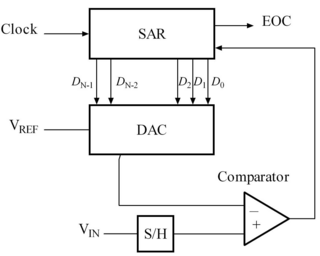
In electronics, an analog-to-digital converter is a system that converts an analog signal, such as a sound picked up by a microphone or light entering a digital camera, into a digital signal. An ADC may also provide an isolated measurement such as an electronic device that converts an analog input voltage or current to a digital number representing the magnitude of the voltage or current. Typically the digital output is a two's complement binary number that is proportional to the input, but there are other possibilities.

In electronics, a comparator is a device that compares two voltages or currents and outputs a digital signal indicating which is larger. It has two analog input terminals and and one binary digital output . The output is ideally

In electronics a relaxation oscillator is a nonlinear electronic oscillator circuit that produces a nonsinusoidal repetitive output signal, such as a triangle wave or square wave. The circuit consists of a feedback loop containing a switching device such as a transistor, comparator, relay, op amp, or a negative resistance device like a tunnel diode, that repetitively charges a capacitor or inductor through a resistance until it reaches a threshold level, then discharges it again. The period of the oscillator depends on the time constant of the capacitor or inductor circuit. The active device switches abruptly between charging and discharging modes, and thus produces a discontinuously changing repetitive waveform. This contrasts with the other type of electronic oscillator, the harmonic or linear oscillator, which uses an amplifier with feedback to excite resonant oscillations in a resonator, producing a sine wave. Relaxation oscillators are used to produce low frequency signals for applications such as blinking lights and electronic beepers and in voltage controlled oscillators (VCOs), inverters and switching power supplies, dual-slope analog to digital converters, and function generators.

In electronics, a Schmitt trigger is a comparator circuit with hysteresis implemented by applying positive feedback to the noninverting input of a comparator or differential amplifier. It is an active circuit which converts an analog input signal to a digital output signal. The circuit is named a trigger because the output retains its value until the input changes sufficiently to trigger a change. In the non-inverting configuration, when the input is higher than a chosen threshold, the output is high. When the input is below a different (lower) chosen threshold the output is low, and when the input is between the two levels the output retains its value. This dual threshold action is called hysteresis and implies that the Schmitt trigger possesses memory and can act as a bistable multivibrator. There is a close relation between the two kinds of circuits: a Schmitt trigger can be converted into a latch and a latch can be converted into a Schmitt trigger.

The 555 timer IC is an integrated circuit (chip) used in a variety of timer, delay, pulse generation, and oscillator applications. Derivatives provide two (556) or four (558) timing circuits in one package. The design was first marketed in 1972 by Signetics. Since then, numerous companies have made the original bipolar timers, as well as similar low-power CMOS timers. In 2017, it was said that over a billion 555 timers are produced annually by some estimates, and that the design was "probably the most popular integrated circuit ever made".
In computer programming, a function object is a construct allowing an object to be invoked or called as if it were an ordinary function, usually with the same syntax. Function objects are often called functors.

In computer science, comparator networks are abstract devices built up of a fixed number of "wires", carrying values, and comparator modules that connect pairs of wires, swapping the values on the wires if they are not in a desired order. Such networks are typically designed to perform sorting on fixed numbers of values, in which case they are called sorting networks.
The sort-merge join is a join algorithm and is used in the implementation of a relational database management system.
Delta-sigma modulation is a method for encoding analog signals into digital signals as found in an analog-to-digital converter (ADC). It is also used to convert high-bit-count, low-frequency digital signals into lower-bit-count, higher-frequency digital signals as part of the process to convert digital signals into analog as part of a digital-to-analog converter (DAC).
The High Precision Event Timer (HPET) is a hardware timer available in modern x86-compatible personal computers. Compared to older types of timers available in the x86 architecture, HPET allows more efficient processing of highly timing-sensitive applications, such as multimedia playback and OS task switching. It was developed jointly by Intel and Microsoft and has been incorporated in PC chipsets since 2005. Formerly referred to by Intel as a Multimedia Timer, the term HPET was selected to avoid confusion with the software multimedia timers introduced in the MultiMedia Extensions to Windows 3.0.

Bitonic mergesort is a parallel algorithm for sorting. It is also used as a construction method for building a sorting network. The algorithm was devised by Ken Batcher. The resulting sorting networks consist of comparators and have a delay of , where is the number of items to be sorted.
A flash ADC is a type of analog-to-digital converter that uses a linear voltage ladder with a comparator at each "rung" of the ladder to compare the input voltage to successive reference voltages. Often these reference ladders are constructed of many resistors; however, modern implementations show that capacitive voltage division is also possible. The output of these comparators is generally fed into a digital encoder, which converts the inputs into a binary value.

A successive-approximation ADC is a type of analog-to-digital converter that converts a continuous analog waveform into a discrete digital representation using a binary search through all possible quantization levels before finally converging upon a digital output for each conversion.
An ABX test is a method of comparing two choices of sensory stimuli to identify detectable differences between them. A subject is presented with two known samples followed by one unknown sample X that is randomly selected from either A or B. The subject is then required to identify X as either A or B. If X cannot be identified reliably with a low p-value in a predetermined number of trials, then the null hypothesis cannot be rejected and it cannot be proven that there is a perceptible difference between A and B.
In electrical systems, a static relay is a type of relay, an electrically operated switch, that has no moving parts. Static relays are contrasted with electromechanical relays, which use moving parts to create a switching action. Both types of relay control electrical circuits through a switch that is open or closed depending upon an electrical input.

An optical comparator or profile projector is a device that applies the principles of optics to the inspection of manufactured parts. In a comparator, the magnified silhouette of a part is projected upon the screen, and the dimensions and geometry of the part are measured against prescribed limits. It is a useful item in a small parts machine shop or production line for the quality control inspection team.
The CAGE Distance Framework identifies Cultural, Administrative, Geographic and Economic differences or distances between countries that companies should address when crafting international strategies. It may also be used to understand patterns of trade, capital, information, and people flows. The framework was developed by Pankaj Ghemawat, a professor at the University of Navarra - IESE Business School in Barcelona, Spain.
In computational complexity theory, CC (Comparator Circuits) is the complexity class containing decision problems which can be solved by comparator circuits of polynomial size.
The "comparator group" is an element that has been used in Canadian jurisprudence to analyze statutory human rights complaints and claims pursuant to section 15 of the Canadian Charter of Rights and Freedoms. Section 15 guarantees equality rights and the right to be free from discrimination on certain enumerated grounds.
A comparator is an electronic component that compares two input voltages. Comparators are closely related to operational amplifiers, but a comparator is designed to operate with positive feedback and with its output saturated at one power rail or the other. If necessary, an op-amp can be pressed into service as a poorly performing comparator, but its slew Rate will be impaired.








